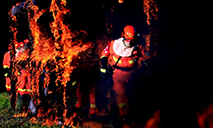NEV production, sales surge 170 percent in China during January-November period
China’s new energy vehicle (NEV) industry has entered into the fast lane in its development.
According to statistics released by the China Association of Automobile Manufacturers, the country produced 3.02 million and sold 2.99 million NEVs in the first 11 months of this year. Both the figures surged by 170 percent.

Customers inspect an SUV of SAIC Motor's R brand in Shanghai. (Photo/China Daily)
Such a performance indicates Chinese President Xi Jinping’s prediction that with a new round of scientific and technological revolution and industrial transformation, the new energy vehicle industry is entering a new stage of accelerated development.
China’s NEV industry has made a series of breakthroughs in core technologies, significantly improved the performance of products and has further expanded its market.
The average energy density of a single cell increased 2.2 times compared with that in 2012, while the overall cost dropped by 85 percent. Besides, the range for pure electric passenger vehicles has now risen to over 500 kilometers. China has ranked first in the world for six consecutive years in terms of its NEV production and sales. As of the end of November this year, the country had sold a total of 8 million NEVs.
In the next five years, the country’s Ministry of Industry and Information Technology, which guides and supervises the development of China’s auto industry, will set higher standards for auto enterprises to raise the quality of their products in terms of their safety, performance in low-temperature environments, etc.
In a smart factory operated by Zeekr, a new electric mobility technology and solutions brand under Chinese carmaker Geely, 382 robotic welders are working together with over 1,700 workers.
“As an emerging Chinese brand for high-end electric vehicles, Zeekr has launched customization services for customers ordering the model Zeekr 001, which means millions of options might be generated,” said An Conghui, Zeekr CEO.
To ensure the efficiency and precision of production, the smart factory has not only built a brand-new smart manufacturing system, but also employed online production supervision methods, such as AI-powered visual diagnosis.
Severe weather conditions such as heavy rain and snow, thick fog, environments with poor lighting conditions, in addition to road hazards such as static objects, slow-moving and abnormally-shaped barriers have always been some of the major “blind spots” for automobile sensing technologies.
To create a pair of sharper “eyes” and a smarter “brain” for the ES33, which is a new model to be launched next year by R Auto, a premium NEV brand under SAIC Motor Passenger Vehicle Co., Ltd., the technical teams for R Auto have established an integrated sensing system, and are currently verifying its sensing capabilities.
The electrification and intelligentization of vehicles have offered a perfect opportunity for Chinese brands to overtake their peers overseas by leaps and bounds, said Chen Kan, a senior manager of R Auto, adding that the auto manufacturer’s high-end smart driving solutions are expected to raise intelligent piloting technologies to a new level.
So far, there are over 5 million connected vehicles in China, and over 20 percent of the vehicles sold on the new vehicle market are equipped with level 2 autonomous driving functions. The country has opened up a total area of 5,000 square kilometers for auto pilot testing, with the total amount of testing mileage having already added up to more than 5 million kilometers.
In the first 11 months of this year, 704,000 sets of new charging facilities were built across China, with the incremental expansion of public charging facilities having increased by 59.1 percent year-on-year, as reported by the China Electric Vehicle Charging Infrastructure Promotion Alliance. As of the end of November this year, the number of charging facilities in China stood at 2.39 million, up 55 percent from a year ago.
Photos
Related Stories
- China boosts battery recycling amid decommissioning surge
- Infographics: China sees its NEV industry in the fast lane
- China's Jiangsu aims to produce 500,000 NEVs yearly by 2025
- Vice premier stresses innovation in China's NEV development
- 2021 World NEV Congress kicks off in China's Hainan
- China's NEV battery output soars over 160 pct in August
Copyright © 2021 People's Daily Online. All Rights Reserved.










